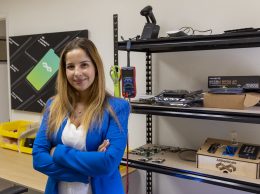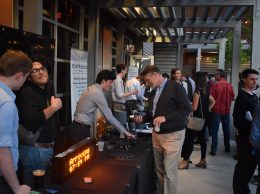Region’s entrepreneurs raise millions with crowdfunding
IN THIS ARTICLE
- Banking & Finance Topic
- Austen Hufford Author
By Austen Hufford Friday, June 27th, 2014
At a weekly board game night, Bill Trammel of San Luis Obispo was fed up with shifting pieces while playing Settlers of Catan.
The board for the massively popular game came in separate pieces designed to be rearranged for each match but often came apart during play. The Cal Poly graduate decided to fix the problem with a plastic base to hold the pieces in place.
He drew up some renderings and posted them to Facebook. Friends commented on the photo asking when they could buy it. The base turned from a late-night distraction into a potential business. But wary of past startups that didn’t work out, Trammel turned to crowdfunding to test the waters.
“I had so many failures in the past,” he said. “I just really wanted to make sure this one worked.”
Crowdfunding taps large numbers of people to pay small amounts to fund projects. Would-be startups put a proposal, funding goal and deadline on a crowdfunding website. Participants are then able to pledge money in exchange for rewards, such as a special edition of the future product. Campaigns use the money to make and deliver products.
According to data compiled by the Business Times, at least $6.3 million has been raised for crowdfunding projects in the Tri-Counties since 2010, with $4.3 million via Kickstarter and an additional $2 million from Indiegogo. So far this year, projects have raised more than $900,000.
After seeing Trammel’s gameboard base prototype, the game’s publisher agreed to license its name to Trammell. He used Kickstarter — the largest crowdfunding website — and set a goal of $25,000 and a deadline of 45 days. With 5,331 backers, Trammel had raised $361,000 for his late-night idea.
In recent years, crowdfunding has skyrocketed in popularity both throughout the nation and in the Tri-Counties. Since launching in 2009, Kickstarter has helped projects raise more than $1 billion. Regionally, a cocktail-creating robot, a sunglasses company and a drone maker have all successfully used the website.
Jai Ranganathan studies crowdfunding of scientific research at UC Santa Barbara’s National Center for Ecological Analysis and Synthesis. His work shows that despite the popular perception of crowdfunding as a “magic spigot of cash,” projects that succeed are usually those that already have an audience when they launch.
Ranganathan said posting a Kickstarter campaign and expecting it to reach its goal without a broader engagement strategy is like opening a shop on State Street and expecting inventory to sell out in two days.
“The mistake everyone makes is that you just put a project up and hope somehow the hype will work,” he said. “You have to build a crowd before you can get funding.”
Gabriel Mountjoy, whose company raised $164,000 for its carbon-fiber wallet, said a lot of work goes into a crowdfunding project both before and during the funding period. You have to build hype. Social media and email are vital tools for spreading the word.
If a project succeeds, even more work unfolds. Ramping up from small batches to mass production almost overnight has caused many crowdfunding projects to fail. And there’s risk for the contributors. Unlike buying a product at a store, there is no guarantee of delivery, and many contributors never get their rewards.
Mountjoy said that for his San Luis Obispo-based company, the ancillary benefits of crowdfunding were in some ways more important than the money. Kickstarter was largely a marketing tool, a way to get in front of future customers who could buy in to the idea. He now has more than 2,500 fans, who can be tapped for market research and support for future products.
Crowdfunding is also a tool for market validation. Instead of spending a ton of money for a product that doesn’t sell, producers can easily gauge consumer interest before embarking on development. Mountjoy used Kickstarter to test his proprietary carbon-fiber hinge and now hopes to take its success to large companies such as airplane makers.
Setting a low and manageable goal is crucial for crowdfunding success, Ranganathan said. Consumers don’t want to invest in a low-interest product or one that won’t meet its goal. Kickstarter, like many crowdfunding sites, requires the goal to be met in order to receive any money.
Even experienced crowdfunders have missteps. In early June, Trammel launched another base for a less popular Settlers of Catan spinoff game. Despite raising more than $100,000, the project wasn’t on track to meet its goal of $200,000. Kickstarter’s algorithm kept it low on the website, he said.
Instead of his company going bankrupt, like a failed product could have caused, he canceled the Kickstarter and launched a new one the same day. The project easily surpassed its more modest goal of $75,000 and has gained the momentum to raise much more, he said.
Trammel enjoys being able to make products without selling equity to outside investors.
Crowdfunding “does require a lot of planning and a lot hurdles to overcome,” he said, “but being able to be the one that decides how to overcome those and being able to control the actions of your company is really valuable.”
Related Articles
 Friday, September 30th, 2022
Friday, September 30th, 2022
In the region and the nation, women get a tiny share of venture capital dollars
 Friday, April 1st, 2022
Friday, April 1st, 2022









